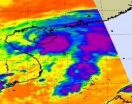Animations show extent of marcellus shale development
2010-10-06
(Press-News.org) The pace and extent of Marcellus Shale development across Pennsylvania can be "seen" in animated maps produced by the Penn State Marcellus Center for Outreach and Research.
Based on data from the Pennsylvania Department of Environmental Protection, the animations (http://www.marcellus.psu.edu/resources/maps.php) show both the number of drilling permits issued for the Marcellus Shale target and the number of wells drilled by year from 2007 through August 2010. Although permits were issued prior to 2007, information on those permits did not include latitude and longitude.
"These animations give people a chance to see how the pace of Marcellus development has accelerated," said Tom Murphy, co-director of the Marcellus Center and extension educator with Penn State Cooperative Extension. "When you look at these animations, you are able to trace where development is occurring and get a sense of the rate at which it is occurring."
The two animations also allow comparison between the number of permits issued and the actual number of wells drilled.
The animations show that interest in the Marcellus has skyrocketed with just 99 drilling permits issued in 2007 compared to 2,108 in the first eight months of 2010. A similar surge in the numbers of wells drilled is also evident. In 2010, through August 31, 950 wells had been drilled in the Marcellus Shale while in all of 2007, only 43 wells were drilled.
"We expect that the uptick in Marcellus well drilling activity will continue, given the high production rates being seen in the wells and the relatively low cost to develop this gas resource," said Michael Arthur, co-director of Penn State's Marcellus Center and professor of geosciences. "Even with the low natural gas commodity pricing, drilling in the Marcellus can still be profitable for efficient companies."
The DEP updates its permit and well reports weekly at http://www.dep.state.pa.us/dep/deputate/minres/oilgas/RIG10.htm. A separate spreadsheet identifies Marcellus permits and whether they are for horizontal or vertical wells.
The Marcellus Shale occurs as deep as 9,000 feet below ground surface and covers about 95,000 square miles over six states including Pennsylvania. Its organic carbon-rich, gas-producing layers range from less than five feet thick to more than 250 feet thick. Estimates are that the Marcellus has enough recoverable natural gas to supply the entire U.S. for at least 20 years at the current rate of consumption.
###
The Marcellus Center for Outreach and Research (www.marcellus.psu.edu) is supported by Penn State Outreach, Penn State Institutes of Energy and the Environment and the colleges of Agricultural Sciences and Earth and Mineral Sciences.
For more information, contact the Marcellus Center for Outreach and Research, marcellus@psu.edu or (814) 865-1587.
END
ELSE PRESS RELEASES FROM THIS DATE:
2010-10-06
Sensation seeking—the urge to do exciting things—has been linked to dopamine, a chemical that carries messages in your brain. For a new study published in Psychological Science, a journal of the Association for Psychological Science, scientists analyzed genes in the dopamine system and found a group of mutations that help predict whether someone is inclined toward sensation seeking.
Sensation seeking has been linked to a range of behavior disorders, such as drug addiction. It isn't all bad, though. "Not everyone who's high on sensation seeking becomes a drug addict. They ...
2010-10-06
DURHAM, N.H. -- Looking at a hagfish – an eyeless, snot-covered, worm-like scavenger of the deep –the last thing that comes to mind is sex. Yet the reproductive functioning of these ancient vertebrates is such an enduring enigma that a gold medal was once offered to anyone who could elucidate it.
Although the prize expired, unclaimed, long ago, University of New Hampshire professor of biochemistry Stacia Sower and colleagues at two Japanese universities have identified the first reproductive hormone of the hagfish – a gonadatropin -- representing a significant step toward ...
2010-10-06
Researchers from Northwestern University and NorthShore University HealthSystem (NorthShore) have developed a method to detect early signs of lung cancer by examining cheek cells in humans using pioneering biophotonics technology.
"By examining the lining of the cheek with this optical technology, we have the potential to prescreen patients at high risk for lung cancer, such as those who smoke, and identify the individuals who would likely benefit from more invasive and expensive tests versus those who don't need additional tests," said Hemant K. Roy, M.D., director ...
2010-10-06
Berkeley – Exposure to dirty air is linked to decreased function of a gene that appears to increase the severity of asthma in children, according to a joint study by researchers at Stanford University and the University of California, Berkeley.
While air pollution is known to be a source of immediate inflammation, this new study provides one of the first pieces of direct evidence that explains how some ambient air pollutants could have long-term effects.
The findings, published in the October 2010 issue of the Journal of Allergy and Clinical Immunology, come from ...
2010-10-06
WEST LAFAYETTE, Ind. - Doppler weather radar will significantly improve forecasting models used to track monsoon systems influencing the monsoon in and around India, according to a research collaboration including Purdue University, the National Center for Atmospheric Research and the Indian Institute of Technology Delhi.
Dev Niyogi, a Purdue associate professor of agronomy and earth and atmospheric sciences, said modeling of a monsoon depression track can have a margin of error of about 200 kilometers for landfall, which can be significant for storms that produce as ...
2010-10-06
The GOES-13 satellite passed over a low pressure area designated as "System 97L" earlier today and captured a visible image of the low in the eastern Caribbean Sea. System 97L appears in a good place for development into a tropical depression in the next day or two.
The National Hurricane Center currently gives the low pressure area known as System 97L an "80 percent chance of developing into a tropical depression in the next 48 hours." The low pressure area is located just north of the Virgin Islands near 19.0 North latitude and 65.3 West longitude. The visible image ...
2010-10-06
The northwestern Pacific Ocean is just as active as the Atlantic Ocean this hurricane season. The fourteenth tropical depression formed near Hainan Island, China this morning and its birth was captured by a NASA infrared satellite instrument. The NASA image showed the depression's strong thunderstorms near its center and east of its center.
NASA's Aqua satellite flew over Tropical Depression 14W (TD14W) today, October 5 at 06:05 UTC (2:05 a.m. EDT). Infrared imagery from the Atmospheric Infrared Sounder (AIRS) instrument onboard the Aqua satellite revealed a concentrated ...
2010-10-06
A new species of dinosaur discovered in Arizona suggests dinosaurs did not spread throughout the world by overpowering other species, but by taking advantage of a natural catastrophe that wiped out their competitors.
The new dinosaur, named Sarahsaurus, was studied by an international team of scientists, including Robert R. Reisz, professor and chair of biology at the University of Toronto Mississauga, Tim Rowe, professor of paleontology at the University of Texas at Austin's Jackson School of Geosciences and Hans-Dieter Sues, curator of vertebrate paleontology at the ...
2010-10-06
The Red Planet bleeds. Not blood, but its atmosphere, slowly trickling away to space. The culprit is our sun, which is using its own breath, the solar wind, and its radiation to rob Mars of its air. The crime may have condemned the planet's surface, once apparently promising for life, to a cold and sterile existence.
Features on Mars resembling dry riverbeds, and the discovery of minerals that form in the presence of water, indicate that Mars once had a thicker atmosphere and was warm enough for liquid water to flow on the surface. However, somehow that thick atmosphere ...
2010-10-06
GREENBELT, Md. – NASA's mission to investigate the mystery of how Mars lost much of its atmosphere passed a critical milestone on October 4, 2010. NASA has given approval for the development and 2013 launch of the Mars Atmosphere and Volatile Evolution (MAVEN) mission.
Clues on the Martian surface, such as features resembling dry riverbeds and minerals that only form in the presence of liquid water, suggest that Mars once had a denser atmosphere, which supported the presence of liquid water on the surface. As part of a dramatic climate change, most of the Martian atmosphere ...
LAST 30 PRESS RELEASES:
[Press-News.org] Animations show extent of marcellus shale development



